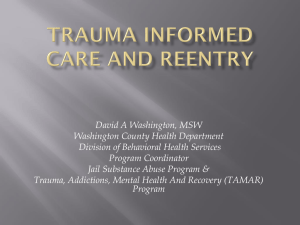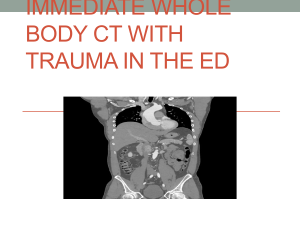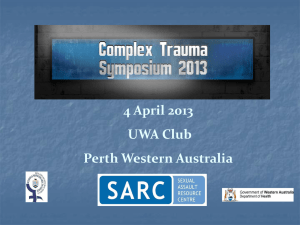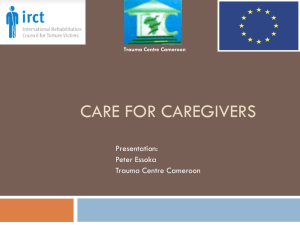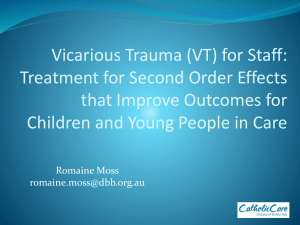Ian Barron
advertisement
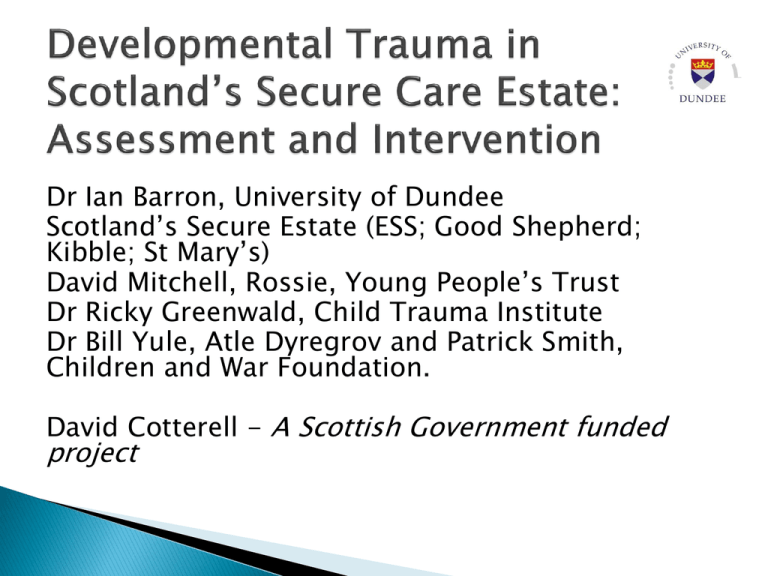
Dr Ian Barron, University of Dundee Scotland’s Secure Estate (ESS; Good Shepherd; Kibble; St Mary’s) David Mitchell, Rossie, Young People’s Trust Dr Ricky Greenwald, Child Trauma Institute Dr Bill Yule, Atle Dyregrov and Patrick Smith, Children and War Foundation. David Cotterell - A Scottish Government funded project • • • • Shift focus - symptom management (attempting to control violence, anger and drugs use) to healing the underlying trauma which (i) drives the behaviour and (ii) results in YP being unresponsive to behavioural programmes Introduce trauma-specific screening and evaluation (i) Develop a developmental trauma framework to case files analysis (PTSD – DSM IV and developmental trauma lens – Bessel Van der Kolk) (i) Trauma history interview (Dr Greenwald’s Treating Problem Behaviour script) (iii) Standardised measures (CRIES-13; MFQ; TGIC; ADES; SDQ). Introduce and evaluate trauma-specific intervention Training for trauma-sensitive milieu Burnt in under severe threat & extreme emotion Triggered by – sensory fragments similar to original trauma, e.g. talking about T; seeing similar face, hearing voice, smell of aftershave, taste … Re-experienced (not re-remembered) in same vividness; body sensations, horror, terror, helplessness as original event; as if ‘happening again’ Activated - re-traumatizes; timeless and immutable; sense of it always in the present; life through trauma lens of terror/helplessness; highly accurate (sensory) Generalised response - Amygdale: smart smoke alarm “any bang becomes a bomb” (Myers, 2009) • • N=17; 14-18yrs; 11 female/6 male; Scottish Caucasian; relative & absolute poverty; poor quality housing/homeless (n=2); parental prostitution (n=5); drug dealing (n=3); substance misusing (n=11); schedule 1 offenders access to home (n=3), mother sectioned under the mental health act (n=1) In free fall , e.g. 40 absconding, 20 break ins, 7 assaults, 3 suicide attempts ….. short period of time. • • • • • • • • Trauma invisible in medical files Physical rather than mental health focus Symptoms rather than diagnosis No connection to embodied symptoms & YP trauma ‘Scatter Gun’ of professional involvement Wide range of ‘types’ of professions recorded per YP Up to 31 different types of professional – frequent changes Omission of survivor organization/expertise Multiple ‘types’ of harm/trauma: 10 different types categorized: sexual abuse (n=12); physical abuse (n=15); physical assault (n=17); experiencing domestic violence (n=12); witnessing domestic violence (n=8); neglect (n=10); emotional abuse (n=7); hospitalisations (n=9); sudden traumatic losses (n=17); and frequent placement change (n=17). Few coherent chronologies (n=4) - despite repeated child death recommendations Despite extensive abuse only 1 YP experienced justice through the Scottish Legal system for harms done to them (perpetrator imprisoned) Vs. • YP experienced multiple child protection case conferences, children’s panels, review meetings, supervision meetings, care plan meetings, police stations, over-night custody and charged with various and numerous offences. • Descriptive behaviours, e.g. hostility, self-harm, drug taking etc. NOT set within trauma lens Omission YP internal intrusive/sensory experiences Few PTSD assessments (n=3; TSSC) & no diagnosis as YP “unpredictable” invalidating result?? N=8 files recognised daily events as behavioural triggers – not connected to historical abuse, e.g. derogatory comments to young people, worries about stability of mother’s residence Extensive behavioural difficulties Multiple charges Severely disrupted educational histories Families relationships characterized by violent chaotic disorder; Violent peer relationships Lack of future hope frequent Negative behaviours/emotions for all (Emotional dys-regulation) Disturbed cognitions rarely reported Re-victimisation statements common Dissociation (n=2) - no evidence professionals making connection between substance misuse/self-harm Depression rarely named (n=3) - symptoms reported • • • • PTSD & developmental trauma symptoms pervasive with YP in secure care Professional reports indicate lack of understanding of the impact of trauma on YPs presenting behavioural difficulties Post-placement decision-making equally characterized by omission of trauma lens No trauma-specific programmes Substantial need across health and welfare services (whole system) working with children, who have been neglected and abused, to understand: (i) the nature of children’s traumatic experience (ii) how to apply this understanding to placement decisions, support and trauma-specific interventions for YP (iii) take cognisance of this during exit planning. • 9 T events on average; multiple 10s cumulative Ts not processing - see cases Multiple T losses: deaths, into care, parent in prison, sibling into care; Violence endemic: gang, assaults experienced and done Agency traumas: returned to abusive home; hearings; in custody; into care (esp. 1st time); secure accommodation No harm conducting Trauma Histories – psycho-education Clinical levels (mostly clusters) of: • PTSD (65%) • Depression (65%) • Dissociation (18%) found in nearly all young people (files) • Clinically significant levels of complicated grief • Underestimated trauma as measures developed around ‘single’ events Safety first; “safe now”; good attachment Stabilization – calming and dissociation techniques - improved affect regulation Core relationship factors – empathic, warm, positive regard, shared understanding & planning Motivational interviewing (bounce effect) Trauma-specific therapies – “face T memory & not overwhelmed, brief exposure, viewing distance, broader perspective, internal processing, dual focus, privacy option, coherent structured narrative” Prolonged exposure – old standard, tell story in detail over and over, - ordeal teenagers as revs up anger/guilt Trauma-focused CBT – write/draw story page by page in a book, piece by piece structure narrative, lot of lab research applied to community MH settings, 8-10 sessions per TM Narrative Exposure Therapy (KidNET), dev with refugees, tell life story with trauma story embedded, rope timeline - stones/flowers, individual & group (4-6 sessions) Traumatic Incident Reduction – guided through imagining the T story 1 to 3 per TM Eye Movement Desensitization Reprocessing – new standard , focus on worst moment during eye movements, brief exposure, associative memory (1-3 sessions?) Progressive Counting – imagine the movie while therapist counts to 100; T memory sandwiched between positive past and future images – contains associative memory (intensive sessions – couple of days!) Group/individual-CBT ‘Teaching Recovery Techniques’ (TRT) • Children and War Foundation - Patrick Smith, Bill Yule & Atle Dyregrov • Psycho-education - Intrusion, Hyper-arousal and Avoidance • Delivered in pairs, three & fours • 7-8 session (vs 5 session) • • • • • • • • • YP (N=17) Intervention / control Presenters PSDO team (n=3) - deliver behavioural change programmes Trauma history interview SUDs; standardized measures (CRIES-13; MFQ; ADES; TGIC; SDQ) 2 weeks pre/post TRT Programme fidelity – video analysis Interviews YP; Staff focus group • • • • • • • • • Large effect size - reducing SUDs Small effect size - behavioural change No statistical difference - standardized measures. Control group made small gains = secure is containing & stabilizing (emotionally) while there YP mostly positive about TRT experience & identified specific helpful aspects Presenters (i) YP selection and grouping important (ii) liaison with care/education staff to enable transfer of YP strategies (iii) further gains after evaluation Programme fidelity very high Substantial financial and post-placement gains were achieved for some young people. Whole staff group evidenced substantial knowledge gains in traumasensitive environments • • • • • • • • Some harm inappropriate to disclosure within a group TRT - assessment of need for in-depth individual T therapy Short duration placement impeding group delivery On site individual therapy provides immediate access to treatment within short placements Individual therapy recognized as standard of care for T treatment (NICE) Evidence suggests TPB phase model enables high levels of engagement & can lead to lasting change, i.e. true healing and transformation TPB is manualised/replicable & developed/tested with secure care populations Cost saving - time limited behavioural stabilization to intensive trauma focused treatment • • • • • • • • • • • 5 provision across the whole secure care estate in Scotland involved By April 2015 - 14 TRT practitioners; 24 TPB practitioners Increased time spent with individual therapy for YP (1st year 5-10% of workers time was increased to 10-30% ; expecting similar increase this year Therapy more intensive (YP tolerate longer sessions) - treatment 4-6 weeks YP entry High standard of supervision - monthly review videotaped sessions & expert consultation with Dr Greenwald Practitioner capacity to adhere to programme implementation fidelity dramatically improved All staff trained in TPB trauma-sensitive milieu – enhances communication programme/care staff Writing reports from T-informed lens (report template and exemplars) Sustainability – trainer of trainers model: 6 accredited TPB ‘trainers’ (Child Trauma Institute); and 10 TRT trainers; international TPB network Increase quality & no. of professionally trained staff / outsourcing Eliminate stakeholders requesting less promising interventions – psychoeducation Field trial T measures into ‘standard evaluative practice’ for benchmarking programmes, practitioners, provision and longitudinal evaluation Standardized measures for assessing cumulative trauma - Children’s Report of Post Traumatic Symptoms (CROPS): Parents Report of Post Traumatic Symptoms (PROPS) and the Problem Behaviour Rating Scale Behavioural tracking (before/during/after) - point/level behaviour systems, incident reports, medical utilisation, school performance, time to discharge, type of discharge to higher/lower level of care Programme adherence through scripts and video Qualitative measures – interviews with staff and young people Placement trajectory costs Thank you i.g.z.barron@dundee.ac.uk




